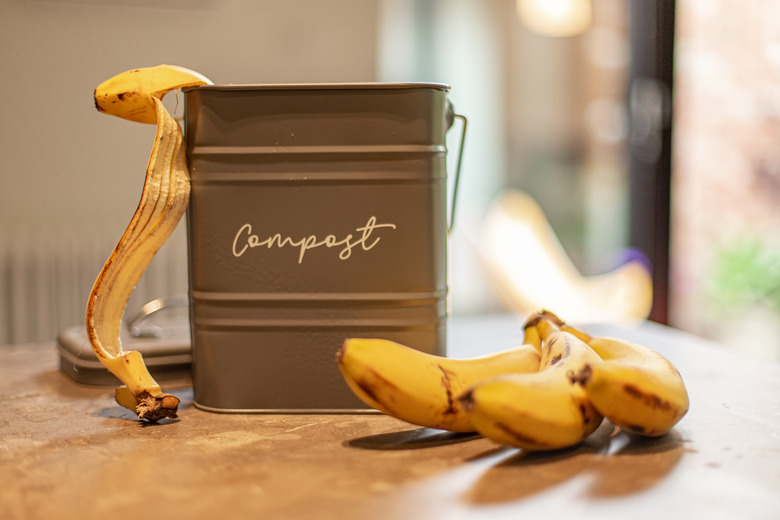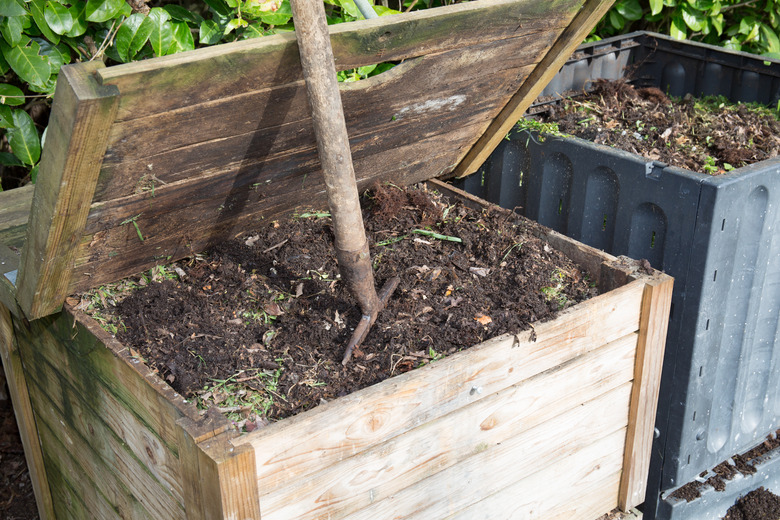Home Composting: A Step-By-Step Guide
We may receive a commission on purchases made from links.
Composting at home can seem confusing because there are so many variations on the theme, but don't let that deter you. The basic idea of composting is to turn garden and kitchen waste into compost — a product that can improve soil quality and also serve as mulch. The process for converting food waste and garden waste into finished compost remains essentially the same whether you make a simple garden compost pile or use a fancy compost tumbler. Once you understand the basic steps, you can start making compost in a backyard corner or whatever bin you have on hand.
The Decomposition Process
The Decomposition Process
The compost process may seem like magic, but it is really nothing more or less than the decomposition process. All organic material — matter that is alive or at one time was alive — will decompose over time, some faster and some slower. A compost pile is made primarily from yard waste (like dry leaves and grass clippings) and kitchen scraps that you would likely otherwise toss in the garbage. As they decompose, they turn into a nutrient-rich soil amendment that will be extremely good for your plants. Composting encourages the production of beneficial bacteria and fungi and reduces methane emissions from landfills too.
If you just tossed this detritus into a pile, you could get a usable product over time, but following a few simple steps will not only speed up the decomposition process but also provide a clean, organic product free of weed seeds and disease-causing organisms.
Understanding Browns and Greens
Understanding Browns and Greens
When you bake your first cake, you follow a recipe, either something passed down from your great-grandmother or something on the internet that looks scrumptious. After time and experience, you get the hang of making a cake, and you may not need to measure every teaspoon.
Just so, there is a recipe for compost that you should follow when you are first getting started. It involves two types of organic material: one called browns and one called greens.
- Browns are high-carbon materials — typically dry plant clippings, like fallen autumn leaves, woody plant stems and wood chips. However, plain cardboard and old newspaper is also considered brown material for composting purposes. They are made from trees and therefore classify as organic.
- Greens are plant matter high in nitrogen, like grass clippings, plant trimmings, vegetable and fruit peels and general kitchen scraps. Less intuitively, coffee grounds and egg shells are also counted as greens. Do not include any meat products, any type of fat or oil or any dairy products.
Both the browns and the greens are used to feed the microorganisms ("microbes") that will ultimately break down all the material. The most common compost recipe is two parts brown material to one part green material, but composting is not a precise science, and you are just as likely to see other recipes too, like three parts brown to one part green or even one part brown to one part green. So, it's not critical to make exact measurements — just keep the general proportions in mind as you go along and put in more brown than green.
How to Compost
1. Site the Composting Bin
Select a location for composting that is about 5 feet square, flat and out of direct sunlight. Check to make sure there are no pipes or rooftops that drain into the area. Take out all weeds and grass in the selected area. Install a store-bought composting bin or compost tumbler in the area. A compost tumbler is a container for compost that has a geared crank. This allows you to turn the container around and around to mix the organic material, saving you some time and effort.
You can also make your own bin using four posts and chicken wire or cinder blocks, leaving holes in the walls for air circulation. Alternatively, make a compost bin from a 32-gallon trash barrel by drilling holes in it for drainage. Even simpler, pile up the organic material to compost directly on the ground.
2. Add Organic Material
Gather your browns and greens near the compost pile or bin. Eliminate any grass trimmings or other plant parts if you've used pesticides or other chemicals on them. Chop up or shred any big or woody pieces to help them decompose quicker. Then, start layering browns and then greens as if you were making lasagna. Finish with a layer of browns to keep away flies and other insects.
Some things should absolutely not go in the compost pile. Don't put in any meal, oil or cheese/butter/milk products at all. Microbes don't decompose these very quickly, and in the meantime, they will be a temptation for animals, including pets and rodents. If this weren't bad enough, these products also smell awful when they rot. Raw eggs generally fall into the same category and can make the entire garden smell bad. Don't toss in dog or cat poop, though some gardeners include barnyard manure from poultry, cattle and horses.
3. Add Soil or Manure
Add a layer of soil or cow manure after the browns and greens for quicker decomposing. Spread on an inch or so to introduce both the microorganisms that actually break down the plant material as well as extra nitrogen. Apply manure without added nitrogen since it is already rich in nitrogen. If you are using soil for this layer, add 1/3 cup nitrogen per 25 square feet of compost surface in the form of ammonium nitrate, blood meal or bone meal.
4. Aerate the Compost
"Aerate" means letting in oxygen, and you need to do this with your compost at least once a week. Your friendly microbes won't be happy if they don't get a good supply of oxygen, and they'll produce that telltale rotten-egg smell. Use a pitchfork or a rake and mix things up well to distribute both moisture and air. Add lightweight matter, like bark mulch, if the compost material feels really thick and hard while stirring. This is when having a compost tumbler comes in handy; all you have to do is give the handle a crank or two, which makes aeration easier.
5. Add Water to the Compost
Add water to your compost regularly but take care not to put in too much since excess water prevents microbes from accessing oxygen. Use a garden hose spray to mist each layer of brown and green as you add it and keep the pile as damp as a wrung-out sponge. Test this by putting on gloves and squeezing a handful of the organic material in the compost. Turn the pile three or four more times if you find that water dribbles out of your handful of compost. Turning it will help dry it out.
If you notice a worm or two in the handful of compost you pick up, pat yourself on the back. Worms are a sign of a healthy compost mixture, and they assist with the decomposition process. Release the worms before you squeeze, though.
6. Take the Compost's Temperature
Buy or borrow an elongated soil thermometer and take the temperature of your compost pile every now and then, especially if you don't see steam rising from it in chilly weather. Microorganism activity should raise the temperature of the compost sufficiently to destroy any pest eggs and weed seeds. If the temperature is above 160 degrees Fahrenheit, aerate it to cool it down a bit. If it's under 105 degrees, pick up some compost starter at the garden store and sprinkle some on to add more microbes and heat up the decomposition process. Keep this product with your garden tools and use it whenever you need to get the compost moving along.
7. Add Another Bin
Add a second or even a third compost bin if you have the space because this enables you to actually use the product more quickly when it is done. Use the first bin for two weeks, adding new brown and green material to it and aerating and watering. At that point, transfer the material to bin number two, putting new browns and greens in number one. Keep aerating and watering both bins. After another two or three weeks, move the contents of the second bin to the third bin and the contents of the first bin to the second bin. After a few more weeks have passed, the compost in bin three is done and ready to be used in the garden.
8. Check the Finished Compost
Mark your calendar the day you first start your compost bin and then start checking it after a month or two to see if it is finished. Check the color and texture; if it's a dark-brown color and a crumbly texture without a lot of "undigested" browns or greens, it may be finished. Check the smell since completed compost smells earthy, rich and sweet. Check the temperature since it drops to the same temperature as the outside air when it is "cooked." For a final test, take a small potful of the compost and sprinkle grass seeds on it. Dig into the pile if the seeds sprout within the next seven days because it means your compost is finished.
Keep in mind that the decomposition speed for compost varies quite a bit. The more you are actively working the compost by turning it and adding water, the sooner you can expect decomposition — sometimes in as little as three weeks in warm weather. However, passive composting — where you pile it up and leave it alone — can take up to a year. In cold weather, count on a minimum of six months, with some thicker materials taking up to a year.
9. Use Your Finished Compost
Use your first batch of finished compost in several ways so that you experience firsthand some of the great things you can do with compost. Try these ideas:
- Work
the compost into the garden soil, adding it to established growing
beds or using it to fill new beds you are just starting. Compost amends the
soil, giving it a lighter consistency while adding nutrients and organic
content. - Layer 2 or 3 inches of compost around trees and
shrubs as mulch, reducing or eliminating weed growth, regulating soil temperature and holding moisture in the soil. Apply it and leave it on until it disintegrates
into the soil over the course of the season, adding nutrients and
organic content. - Mix one part compost with one part soilless growing medium and use this for flower transplants and container plants.
- Make
compost tea by soaking one part compost in five parts water for three days and
then straining it. Use the tea to water and feed plants at the same time. It
works especially well for fertilizing seedlings and
transplants. You can also spray it on foliage to prevent fungal diseases.

